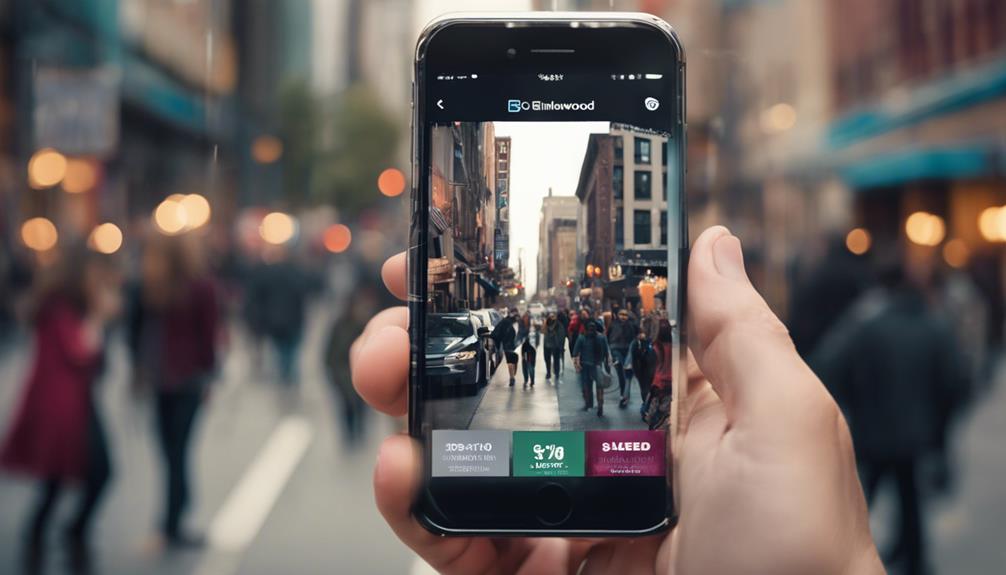Social Media Marketing for Local Businesses
As a local business owner, you're likely no stranger to the importance of having a strong online presence. But are you using social media to its full potential? By establishing a solid social media strategy, you can increase brand awareness, drive website traffic, and generate leads. But where do you start? With so many platforms and tactics to choose from, it can be overwhelming. You're probably wondering which platforms are right for your business, what kind of content resonates with your audience, and how to measure success.
Key Takeaways
- Establish professional social media accounts on popular platforms to build brand credibility and visibility for local businesses.
- Identify target audience and prioritize platforms they're most active on to maximize online presence and engagement.
- Engage with local residents by responding to comments, hosting online events, and sharing user-generated content to build trust and authority.
- Create a local online community by collaborating with influencers, sharing exclusive offers, and featuring customer testimonials to foster neighborhood connections.
Setting Up Social Media Accounts
As you set out on your social media marketing journey, establishing a strong online presence begins with setting up professional accounts on the most popular platforms, including Facebook, Twitter, Instagram, and LinkedIn.
This is a pivotal step in building your brand's credibility and visibility.
When creating your accounts, make sure to use your business's official name and maintain consistency across all platforms.
Next, prioritize account security by using strong, unique passwords and enabling two-factor authentication.
This will protect your accounts from unauthorized access and potential data breaches.
You should also limit access to your accounts by assigning specific roles to team members or employees.
Once your accounts are secure, focus on profile optimization.
Complete your profiles by adding a profile picture, cover photo, and bio that accurately represents your business.
Use relevant keywords in your bio to improve search engine optimization (SEO).
Additionally, verify that your profiles are uniform in regard to tone, voice, and visual branding.
Choosing the Right Platforms
When choosing the right social media platforms for your marketing strategy, you'll need to weigh a few key factors.
First, you'll want to identify your target audience and the platforms they're most active on.
Identify Target Audience
To develop an effective social media marketing strategy, you need to pinpoint your ideal customer, understanding their demographics, interests, and online behaviors to choose the right platforms that align with their habits.
This involves conducting a thorough demographic analysis to identify age, gender, location, and income levels of your target audience.
By doing so, you can create customer personas that help you visualize and connect with your ideal customer on a deeper level.
These personas should outline their pain points, goals, and behaviors, including what motivates them to engage with your brand online.
For instance, are they more likely to use Instagram for visual inspiration or LinkedIn for professional networking?
Understanding these nuances will enable you to tailor your content and messaging to resonate with your target audience.
Assess Platform Features
Your target audience's online behaviors and preferences now guide your assessment of social media platforms, where you'll evaluate features that align with their needs and your marketing goals. This platform analysis is pivotal in determining which channels will yield the best returns for your local business.
To facilitate a thorough feature comparison, consider the following key aspects:
| Platform | Content Style | Engagement Features |
|---|---|---|
| Long-form posts, videos | Groups, Messenger, Reactions | |
| Visual-centric, short captions | Stories, Reels, Hashtags | |
| Short-form, real-time updates | @Mentions, Hashtags, Polls | |
| YouTube | Long-form videos, tutorials | Comments, Subscriptions, End Screens |
When evaluating each platform, ask yourself: Which features align with my target audience's preferences? Which platforms offer the most suitable content styles for my marketing goals? By answering these questions, you'll be able to narrow down the most effective platforms for your local business, ensuring your social media marketing efforts are targeted and impactful.
Consider Business Goals
With your target audience's online behaviors and platform features in mind, you must now align these insights with your business goals to determine the most effective social media platforms for your local business.
This step is vital, as it guarantees your social media marketing efforts support your overall business objectives.
Take a closer look at your business goals and identify what you want to achieve through social media marketing. Are you looking to increase brand awareness, drive website traffic, or generate leads? Perhaps you want to boost sales or improve customer engagement.
Once you've clarified your business objectives, assess how they align with your marketing strategies.
Ask yourself, which social media platforms will best help you achieve these goals? For instance, if you're focused on generating leads, LinkedIn might be a top choice. If you're looking to drive website traffic, Facebook and Instagram could be more effective.
Crafting a Compelling Content Strategy
As you develop a social media marketing strategy, creating content that resonates with your target audience is crucial, and it all starts with crafting a compelling content strategy.
A well-planned content strategy helps you consistently publish high-quality content that aligns with your business goals and resonates with your audience.
To create a compelling content strategy, consider the following:
Define your brand voice: Develop a unique tone and language that reflects your brand's personality and values.
Identify your content pillars: Determine the core topics and themes that align with your business goals and resonate with your audience.
Plan your content calendar: Organize and schedule your content in advance to guarantee consistency and efficiency.
Create engaging formats: Mix and match content formats such as videos, images, blog posts, and stories to cater to different learning styles and preferences.
Measure and adjust: Continuously monitor your content's performance, gather feedback, and adjust your strategy to optimize results.
Building a Local Online Community
When building a local online community, you'll want to focus on engaging with local residents and fostering neighborhood connections.
You can do this by creating content that resonates with your local audience, hosting online events or Q&A sessions, and encouraging user-generated content.
Engage With Local Residents
You can substantially boost your local online presence by actively participating in online conversations, responding to comments, and sharing user-generated content that resonates with local residents. This helps build trust and establishes your business as an authority in the community.
By engaging with local residents, you'll gain valuable Local Insights into their needs, preferences, and pain points, allowing you to tailor your marketing strategy accordingly.
Host Q&A sessions or live events on social media to encourage interaction and gather feedback.
Share behind-the-scenes content that showcases your business's involvement in local events or charities.
Create a social media group or forum where locals can discuss topics related to your business or industry.
Collaborate with local influencers or bloggers to reach a wider audience.
Share customer testimonials and reviews to build social proof and credibility.
Foster Neighborhood Connections
By building a local online community, your business can tap into the collective knowledge, experiences, and networks of neighborhood residents, ultimately driving customer loyalty and advocacy.
This community building effort allows you to connect with locals on a deeper level, fostering a sense of belonging and Local Pride.
You can achieve this by creating a private Facebook group or online forum where residents can share their thoughts, ask questions, and provide feedback.
As the community grows, you'll be able to identify local influencers and brand ambassadors who can help spread the word about your business.
You can also use this platform to share exclusive offers, promotions, and events, making community members feel valued and appreciated.
By doing so, you'll create a loyal customer base that will advocate for your business, driving referrals and positive reviews.
Remember, community building is an ongoing process that requires consistent effort and engagement.
Be sure to actively participate in the community, respond to comments and concerns, and continuously provide value to maintain a strong online presence.
Leveraging User-Generated Content
Social media platforms are overflowing with user-generated content, a goldmine of social proof that can be harnessed to amplify your brand's message and credibility. You can leverage this content to create a loyal community and increase engagement. By doing so, you'll not only save time and resources but also get authentic endorsements from your customers.
Run Content Campaigns: Launch a campaign that encourages customers to share their experiences, photos, or videos with your brand. This can be done through social media contests, hashtag challenges, or email requests.
Create a Customer Showcase: Dedicate a section on your website or social media page to feature customer testimonials, reviews, and stories.
Use Customer Photos in Ads: Use real customer photos in your ads to increase their effectiveness and credibility.
Share User-Generated Content on Social Media: Share customer content on your social media pages to show that you value their opinions and experiences.
Make it Easy to Share: Add shareable content on your website, such as 'share your story' buttons, to encourage customers to share their experiences with others.
Measuring Social Media Success
Tracking the right metrics is crucial to understanding whether your social media efforts are driving real results for your business.
You can't just post content and hope for the best; you need to measure your performance to see what's working and what's not.
So, what social metrics should you be tracking?
Start by monitoring your engagement rates, such as likes, comments, and shares.
These metrics will give you an idea of how well your content is resonating with your audience.
You should also keep an eye on your follower growth rate, as it indicates whether your content is attracting new customers.
Additionally, track your website traffic and conversions to see if your social media efforts are driving sales.
Tracking progress over time will help you identify patterns and trends, allowing you to adjust your strategy accordingly.
Creating Engaging Visual Content
As you craft your social media strategy, you'll want to focus on creating visual content that stops scrollers in their tracks.
To do this, you'll need to master the basics of visual storytelling, learn how to create eye-catching images that resonate with your audience, and develop a consistent brand identity through graphics.
Visual Storytelling Basics
You'll capture your audience's attention and convey complex ideas more effectively by crafting engaging visual content that tells a story, leveraging the brain's natural inclination to process images 60,000 times faster than text.
Visual storytelling is a powerful tool in social media marketing, allowing you to communicate your message in a concise and memorable way.
To get started, focus on the basics:
Establish an Image Hierarchy
Organize your visual elements to draw attention to the most important information, creating a clear flow of attention.
Storyboard Essentials
Plan your visual narrative by breaking down your story into individual frames, ensuring a cohesive and engaging sequence.
Use Contrasting Colors
Make your visuals pop by selecting colors that stand out from the background, grabbing your audience's attention.
Balance Text and Images
Find the perfect ratio of text to images, ensuring your message is clear and easy to consume.
Keep it Simple
Avoid clutter and focus on simplicity, allowing your audience to quickly understand your message.
Eye-Catching Image Creation
By incorporating high-quality, relevant, and attention-grabbing images into your social media content, you can substantially increase engagement, drive conversions, and build a strong brand identity.
Eye-catching images are essential for breaking through the noise on social media platforms, where users are bombarded with content every second.
To create engaging visual content, you'll need to develop your image editing skills. Familiarize yourself with graphic design principles and learn to use image editing tools like Adobe Photoshop or Canva.
These tools will enable you to crop, resize, and enhance your images, making them more visually appealing. You can also use them to add text, logos, or other design elements to your images, giving them a professional touch.
Branding Through Graphics
Consistently incorporating distinctive graphics into your social media content helps establish a recognizable brand identity that resonates with your target audience. This is vital in creating engaging visual content that sets you apart from the competition. By developing a unique visual identity, you can build trust and credibility with your audience.
To create a strong visual identity, consider the following:
Define a consistent color scheme: Choose 2-3 core colors that reflect your brand's personality and use them across all your social media platforms.
Use custom typography: Select a font or font combination that aligns with your brand's tone and style.
Create a logo variation library: Develop a range of logo variations that can be used across different social media platforms and content types.
Establish a visual tone: Determine the tone and mood you want to convey through your visuals, such as playful, professional, or inspirational.
Develop a brand pattern library: Design a set of patterns, textures, or icons that can be used to add visual interest to your content.
Running Targeted Social Ads
With over 3.8 billion people using social media platforms, running targeted social ads allows you to reach your ideal customer with precision, increasing brand awareness and driving conversions.
To get the most out of your ad spend, you need to understand ad targeting options. You can target based on demographics, interests, behaviors, and even custom audiences.
For instance, if you're a local restaurant, you can target people who live or work within a specific radius of your location. You can also target users who've shown interest in food-related topics or have similar characteristics to your existing customers.
When allocating your budget, having a strategy in place is crucial. You can set a daily or lifetime budget, and choose between cost-per-click (CPC) or cost-per-thousand impressions (CPM) bidding.
Consider setting aside a portion of your budget for ad testing and optimization. By continuously monitoring your ad performance and adjusting your targeting options and budget allocation, you can guarantee that your social ads are driving real results for your local business.
Managing Online Reputation Effectively
As you navigate the complex landscape of social media, it's essential that you proactively monitor and manage your online reputation to guarantee that your brand's image remains intact and continues to resonate with your target audience.
This involves tracking online reviews, mentions, and feedback across various platforms to certify that your brand's voice is consistent and positive.
Conduct regular reputation analysis to identify areas of improvement and opportunities for growth.
Respond promptly to customer complaints and feedback to showcase your commitment to customer satisfaction.
Encourage satisfied customers to leave online reviews and ratings to build credibility and trust.
Monitor social media conversations about your brand and industry to stay ahead of the curve.
Develop a crisis management plan to address any potential online reputation crises that may arise.
Optimizing Social Media for SEO
Optimizing Social Media for SEO
By incorporating strategic keywords and hashtags into your social media content, you can substantially boost your brand's online visibility and drive more traffic to your website through search engine optimization.
This is vital, as search engines like Google crawl social media platforms to index content and improve search results. A well-planned keyword strategy can help you rank higher in search engine results pages (SERPs), increasing your online presence and credibility.
To optimize your social media for SEO, start by identifying relevant keywords and phrases that align with your business goals and target audience.
Use these keywords in your social media profiles, posts, and hashtags to create a consistent brand message.
Confirm your social media profiles are complete, including a profile picture, cover photo, and bio that includes your target keywords.
By doing so, you'll improve your chances of appearing in search engine results, driving more traffic to your website and increasing conversions.
Frequently Asked Questions
How Often Should I Post on Social Media to Avoid Annoying Customers?
When deciding posting frequency, you'll want to balance visibility with audience fatigue. Aim for 3-5 posts weekly, monitoring engagement to avoid overwhelming followers, and adjust your schedule based on their feedback and response.
Can I Use Social Media for Business if I'm Not Tech-Savvy?
You don't have to be a tech whiz to use social media for business! With basic training, you can master simple strategies to create engaging content, grow your online presence, and connect with customers.
Is Social Media Worth It for a Small Business With Low Sales?
You're wondering if social media's worth it with low sales. Honestly, it depends on how you allocate resources. If you can measure a tangible sales impact, it's worth the investment, but if not, reassess your strategy.
How Do I Handle Negative Reviews and Complaints on Social Media?
When handling negative reviews and complaints on social media, you'll want to respond promptly with a personalized review response, acknowledge the issue, and provide a solution, showcasing your commitment to effective complaint handling.
Do I Need to Hire a Social Media Manager or Can I Diy?
When managing your online presence, you're faced with the dilemma of whether to DIY or hire a social media manager. With time constraints and resource allocation in mind, consider if you can realistically dedicate hours to creating content and engaging with followers.
Conclusion
By implementing these social media marketing strategies, you'll be well on your way to establishing a strong online presence, driving website traffic, and generating leads for your local business.
Remember to track your progress, adjust your approach as needed, and continually create engaging content that resonates with your target audience.
With persistence and creativity, you'll build a loyal community and stay ahead of the competition in the ever-evolving world of social media marketing.







